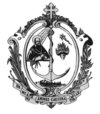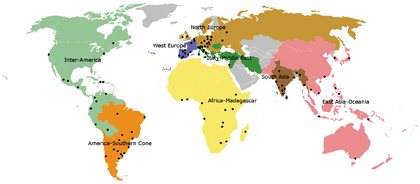- Salesians of Don Bosco
-
This article is about the religious order. For schools bearing the name, see Salesian School (disambiguation).
The Salesians of Don Bosco (or the Salesian Society, originally known as the Society of St. Francis de Sales) is a Roman Catholic religious order founded in the late nineteenth century by Saint John Bosco in an attempt, through works of charity, to care for the young and poor children of the industrial revolution. The Salesians' charter describes the society's mission as "the Christian perfection of its associates obtained by the exercise of spiritual and corporal works of charity towards the young, especially the poor, and the education of boys to the priesthood".[1] The order is named for St. Francis de Sales, an early-modern bishop of Geneva.
Contents
History
In 1845 Don John Bosco ("Don" being a traditional Italian honorific for a priest) opened a night school for boys in Valdocco, now part of the municipality of Turin in Italy. In the coming years, he opened several more schools, and in 1857 drew up a set of rules for his helpers, which became the Rule of the Society of St. Francis de Sales, which Pope Pius IX approved definitively in 1873. The order grew rapidly, with houses established in France and Argentina within a year of the society's formal recognition. The order's official print organ, the Salesian Bulletin, was first published in 1877. Over the next decade, the Salesians expanded into Austria, Britain, Spain, and several countries in South America. The death of Don Bosco in 1888 did not slow the order's growth, and by 1911 the Salesians were established throughout the world, including Colombia, China, India, South Africa, Tunisia, Venezuela and the United States. The society continues to operate worldwide; in 2000, it counted more than 20,000 members in 2,711 houses. It is the third largest missionary organization in the world.[2]
Logo of the Society
The logo is designed with the central theme DON BOSCO AND THE SALESIANS WALKING WITH THE YOUNG THROUGH THE WORLD.
The logo of the Salesians of Don Bosco is made up of two superimposed images: in the background a stylised “S” (Salesians) in white is formed within a sphere like a globe marked to the right and left by two cuttings between the hills/dunes The second image is in the centre of the globe bridging the “S” road. This is an arrow pointing upwards resting on three perpendicular legs on top of which are three closed circles making a stylised image of three people: the first of these in the midde and taller than the others is the point of the arrow, and the other two beside it appear as it were to be embraced by the central figure. The three stylised figures with the arrow pointing upwards can also be viewed as a simple dwelling with a sloping roof (the arms) and with pillars holding it up (the bodies of the three people).
Various Elements of the New Logo
- Don Bosco, the Salesian and young people: Three stylized figures represent St. John Bosco reaching out to the young, and his call for Salesians to continue his work
- The Salesian charism and the preventive system: The road represents an educational journey for the youth, the house represents Bosco's Oratories of Reason, Religion, and Kindness (three columns of house).
- The Salesian charism, relevant and worldwide: The background is a stylized heart that is also reminiscent of a globe.
Relation to the Traditional Coat of Arms
Traditional Coat of Arms New Salesian Logo Three Virtues (Faith, Hope, Kindness) Star, Anchor, Inflamed Heart Three circles Patron of the Salesians Image of St. Francis de Sales Stylized 'S' Founder of the Salesians The wood (Bosco) Central figure of three persons Perfection and Aspiration Mountains (height) Road (journey) Virtue and Sacrifice Intertwined palm and laurel Circular stylized heart / open arms of central figure Salesian Motto Ribbon containing Da Mihi Animas Caetera Tolle' Saint John Bosco with open arms Process of Logo Selection
The new logo is the result of combining two logos already established for years in some parts of the Congregation: the German logo and the Brazilian logo.
The idea of combining the two came out of suggestions from an enquiry about the new logo conducted throughout the Congregation and from contributions by the General Council.
The combination, besides profiting from the mutual enrichment of the elements, is intended to be an expression of communion and of intercultural dialogue.
The artistic work of combining the two was carried out by the designer Fabrizio Emigli, from the Litos Company, in Rome.
Organization
The Salesians of Don Bosco are headed by the Rector Major and the society's general council; each of the ninety-four geographical provinces is headed by a Provincial. These officers serve six-year terms; the Rector Major and the members of the general council are elected by the Chapter General, which meets every six years or upon the death of the Rector Major. Each local Salesian community is headed by a superior, called a Rector (or more commonly, "Director"), who is appointed to a three-year term and can be renewed for a second three-year term.
Works
Salesian communities primarily operate shelters for homeless or at-risk youths; schools; technical, vocational, and language instruction centers for youths and adults; and boys' clubs and community centers. In some areas they run parish churches. Salesians are also active in publishing and other public communication activities, as well as mission work, especially in Asia (Siberia - in the Yakutsk area), Africa, and South America (Yanomami). The Salesian Bulletin is now published in fifty-two editions, in thirty languages.
In the 1990s Salesians launched new works in the area of tertiary education, and today have a network of over 58 colleges and universities. The official university of the Salesian Society is the Salesian Pontifical University in Rome.
Salesian Sisters
The women's order is known as the Salesian Sisters of Don Bosco or the Daughters of Mary Help of Christians.
Visitationist sisters, members of the Order of the Visitation of Holy Mary, are also sometimes called Salesian Sisters, in honor of one of their founders, Saint Francis de Sales. However, the two societies are not the same and their membership does not overlap.
Famous Members
- Tarcisio Bertone
- Raffaele Farina
- Miguel Obando y Bravo
- Óscar Andrés Rodríguez Maradiaga
- Joseph Zen Ze-kiun
See also
- Category:Salesians
- Don Bosco School
- Salesian Missions
- Rector Major of the Salesians
- Bosco Seva Kendra, Development Office of the Salesian Province of Hyderabad in India.
- Bartolome Blanco Marquez, martyr of the religious persecutions of the Spanish Civil War
- Salesians in Hungary
- Salesians in Malta
- Croatian Salesian Province of Saint Don Bosco
- Giuseppe Moja
References
- Based on Catholic Encyclopedia entry, abbreviated and rewritten for NPOV.
1Provided by The Social Communication Department, Rome, 20 November 2003
Historical people Places Santuario di Maria AusiliatricePeople Rettor Maggiore dei SalesianiCatholic Church Organizations, Papacy, Teachings and Liturgical TraditionsHistory Jesus · Twelve Apostles · Early Christianity · History of the Papacy · Ecumenical Councils · Missions · Great Schism of East · Crusades · Great Schism of West · Protestant Reformation · Counter-Reformation · Catholic Church by country
Hierarchy Pope · Cardinals · Patriarchs · Major Archbishops · Primates · Metropolitans · Archbishops · Diocesan BishopsTheology Sacraments Mariology Doctors of
the ChurchAlbertus Magnus · Ambrose · Anselm of Canterbury · Anthony of Padua · Thomas Aquinas · Athanasius of Alexandria · Augustine of Hippo · Basil of Caesarea · Bede · Robert Bellarmine · Bernard of Clairvaux · Bonaventure · Petrus Canisius · Catherine of Siena · Peter Chrysologus · John Chrysostom · Cyril of Alexandria · Cyril of Jerusalem · Peter Damian · Ephrem the Syrian · Francis de Sales · Gregory of Nazianzus · Gregory the Great · Hilary of Poitiers · Isidore of Seville · Jerome · John of Damascus · John of the Cross · Lawrence of Brindisi · Leo the Great · Alphonsus Maria de Liguori · Teresa of Ávila · Thérèse of LisieuxPope Benedict XVI Preceding Popes Orders and
SocietiesVatican II Particular Churches
sorted by
Liturgical TraditionsAlexandrian · Coptic · Ethiopic · Antiochian · Maronite · Syriac · Syro-Malankara · Armenian · Armenian · Byzantine · Albanian · Belarusian · Bulgarian · Croatian · Greek · Hungarian · Italo-Albanian · Macedonian · Melkite · Romanian · Russian · Ruthenian · Slovak · Ukrainian · East Syrian · Chaldean · Syro-Malabar · Latin · Roman · Anglican Use · Sarum · Ambrosian · Mozarabicr
External links
(Please see 1THE LOGO OF THE HEADQUARTERS OF THE SALESIANS OF DON BOSCO)
Categories:- Roman Catholic missionary orders
- Salesian Order
- Religious organizations established in 1874
- Founders of Indian schools and colleges
Wikimedia Foundation. 2010.





